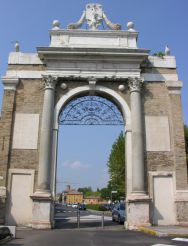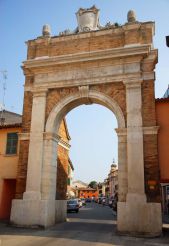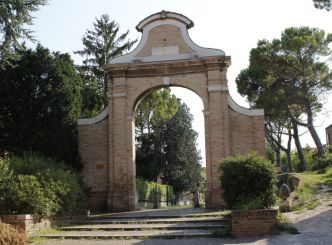Porta Nuova, Ravenna

Porta Nuova is one of the most beautiful and significant gates in Ravenna. This monumental and truly iconic construction has a rich history and an equally luxurious appearance. At one point, these city gates played a very important role in the defense of Ravenna.
History of Porta Nuova
In 1578, it was decided to replace old dilapidated Porta San Lorenzo. In 1580 the construction of Porta Nuovo began 150 meters away from the old ones. Architect Galeotto Monaldini was put in charge of the project. These works were a part of the reconstruction that the whole city district underwent, including the repaving of the road that led to Cervia and the creation of the church of Santa Maria Maggiore. The construction was completed in 1585, and it was named Porta Gregoriana to honor Pope Gregory XIII. Throughout many years, the gate remained closed, as the authorities feared enemy attacks from the south. In 1653, Cardinal Giovanni Stefano Donghi built a new fairway that adjoined the gate which was restored and named Porta Pamphilia to honor Pope Innocent X (also referred to as Giovanni Battista Pamphilj).
In the early 19th century, architect Pietro Matteucci created a проект aimed to restore the gates which, however, wasn't realized. After the unification of Italy in 1861, the gate was named after Garibaldi for some time. During 1883–1929 years, there was a tram line under the arch. On December 4, 1944, partisans and ally troops that liberated Ravenna walked through the gate into the city. To mark this event a sign was installed in 1997. The last restoration of the gates was performed in 2004.
Design
The main material used to build the gate is brick. The arched entrance is decorated with two gray granite Corinthian columns. They serve as a support for the marble balustrade. You might notice a writing on it which says “Porta Pamphilia” – it has been there since 1653. On the sides of the balustrade, there are two figures of doves with an olive branch in their beaks. The gate is crowned with two cornucopias and a dove holding a medallion with three lilies. All this symbolism is directly related to Pope Gregory XIII. On both sides of the arch of the gate, there are memorial plates placed in honor of the fallen patriots and resistance fighters: Francesco Segurini (1921) and Mario Montanari (1944).
How to get
Porta Nuova is located in the southern part of Ravenna, near the historical center, on Via di Roma, 2. The Ravenna Art Museum, as well as Porta Sisi, Porta Ravegnana and Porta San Mamante, can be found in the same area. The closest bus stop is Viale Santi Baldini Scuole, you can catch buses 4, 147, 149, 156, 176 there.







